Ectopic notch activation in developing podocytes causes glomerulosclerosis
- PMID: 18337488
- PMCID: PMC2396929
- DOI: 10.1681/ASN.2007050596
Ectopic notch activation in developing podocytes causes glomerulosclerosis
Abstract
Genetic evidence supports an early role for Notch signaling in the fate of podocytes during glomerular development. Decreased expression of Notch transcriptional targets in developing podocytes after the determination of cell fate suggests that constitutive Notch signaling may oppose podocyte differentiation. This study determined the effects of constitutive Notch signaling on podocyte differentiation by ectopically expressing Notch's intracellular domain (NOTCH-IC), the biologically active, intracellular product of proteolytic cleavage of the Notch receptor, in developing podocytes of transgenic mice. Histologic and molecular analyses revealed normal glomerular morphology and expression of podocyte markers in newborn NOTCH-IC-expressing mice; however, mice developed severe proteinuria and showed evidence of progressive glomerulosclerosis at 2 wk after birth. Features of mature podocytes were lost: Foot processes were effaced; expression of Wt1, Nphs1, and Nphs2 was downregulated; cell-cycle re-entry was induced; and the expression of Pax2 was increased. In contrast, mice with podocyte-specific inactivation of Rbpsuh, which encodes a protein essential for canonical Notch signaling, seemed normal. In addition, the damaging effects of NOTCH-IC expression were prevented in transgenic mice after simultaneous conditional inactivation of Rbpsuh in murine podocytes. These results suggest that Notch signaling is dispensable during terminal differentiation of podocytes but that constitutive (or inappropriate) Notch signaling is deleterious, leading to glomerulosclerosis.
Figures
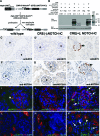
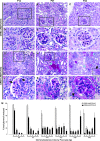


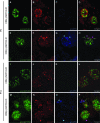


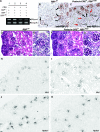
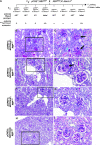
Comment in
-
Notch signaling: a common pathway of injury in podocytopathies?J Am Soc Nephrol. 2008 Jun;19(6):1045-6. doi: 10.1681/ASN.2008040351. Epub 2008 May 14. J Am Soc Nephrol. 2008. PMID: 18480311 No abstract available.
Similar articles
-
Notch activation differentially regulates renal progenitors proliferation and differentiation toward the podocyte lineage in glomerular disorders.Stem Cells. 2010 Sep;28(9):1674-85. doi: 10.1002/stem.492. Stem Cells. 2010. PMID: 20680961 Free PMC article.
-
Gα12 activation in podocytes leads to cumulative changes in glomerular collagen expression, proteinuria and glomerulosclerosis.Lab Invest. 2012 May;92(5):662-75. doi: 10.1038/labinvest.2011.198. Epub 2012 Jan 16. Lab Invest. 2012. PMID: 22249312 Free PMC article.
-
Podocyte hypertrophy, "adaptation," and "decompensation" associated with glomerular enlargement and glomerulosclerosis in the aging rat: prevention by calorie restriction.J Am Soc Nephrol. 2005 Oct;16(10):2953-66. doi: 10.1681/ASN.2005050488. Epub 2005 Aug 24. J Am Soc Nephrol. 2005. PMID: 16120818
-
[The role of podocyte damage in the pathogenesis of glomerulosclerosis and possible repair mechanisms].G Ital Nefrol. 2009 Nov-Dec;26(6):660-9. G Ital Nefrol. 2009. PMID: 19918748 Review. Italian.
-
[The role of podocyte injury in chronic kidney disease].Nihon Rinsho Meneki Gakkai Kaishi. 2015;38(1):26-36. doi: 10.2177/jsci.38.26. Nihon Rinsho Meneki Gakkai Kaishi. 2015. PMID: 25765686 Review. Japanese.
Cited by
-
Notch signaling in diabetic nephropathy.Exp Cell Res. 2012 May 15;318(9):986-92. doi: 10.1016/j.yexcr.2012.02.036. Epub 2012 Mar 5. Exp Cell Res. 2012. PMID: 22414874 Free PMC article. Review.
-
Childhood nephrotic syndrome--current and future therapies.Nat Rev Nephrol. 2012 Jun 12;8(8):445-58. doi: 10.1038/nrneph.2012.115. Nat Rev Nephrol. 2012. PMID: 22688744 Review.
-
Notch Signaling in Kidney Development, Maintenance, and Disease.Biomolecules. 2019 Nov 4;9(11):692. doi: 10.3390/biom9110692. Biomolecules. 2019. PMID: 31690016 Free PMC article. Review.
-
Kick it up a notch: Notch signaling and kidney fibrosis.Kidney Int Suppl (2011). 2014 Nov;4(1):91-96. doi: 10.1038/kisup.2014.17. Kidney Int Suppl (2011). 2014. PMID: 26312157 Free PMC article. Review.
-
Targeted disruption of the histone lysine 79 methyltransferase Dot1L in nephron progenitors causes congenital renal dysplasia.Epigenetics. 2021 Nov;16(11):1235-1250. doi: 10.1080/15592294.2020.1861168. Epub 2020 Dec 29. Epigenetics. 2021. PMID: 33315499 Free PMC article.
References
-
- Wang P, Pereira FA, Beasley D, Zheng H: Presenilins are required for the formation of comma- and S-shaped bodies during nephrogenesis. Development 130: 5019–5029, 2003 - PubMed
-
- Cheng HT, Miner JH, Lin M, Tansey MG, Roth K, Kopan R: Gamma-secretase activity is dispensable for mesenchyme-to-epithelium transition but required for podocyte and proximal tubule formation in developing mouse kidney. Development 130: 5031–5042, 2003 - PubMed
-
- Kadesch T: Notch signaling: The demise of elegant simplicity. Curr Opin Genet Dev 14: 506–512, 2004 - PubMed
-
- Schroeter EH, Kisslinger JA, Kopan R: Notch-1 signaling requires ligand-induced proteolytic release of intracellular domain. Nature 393: 382–386, 1998 - PubMed
Publication types
MeSH terms
Substances
Grants and funding
LinkOut - more resources
Full Text Sources
Molecular Biology Databases

